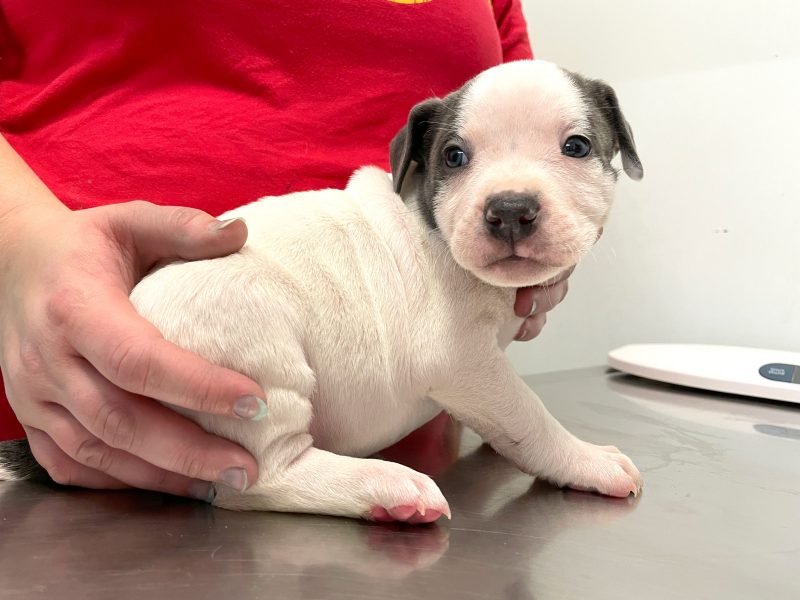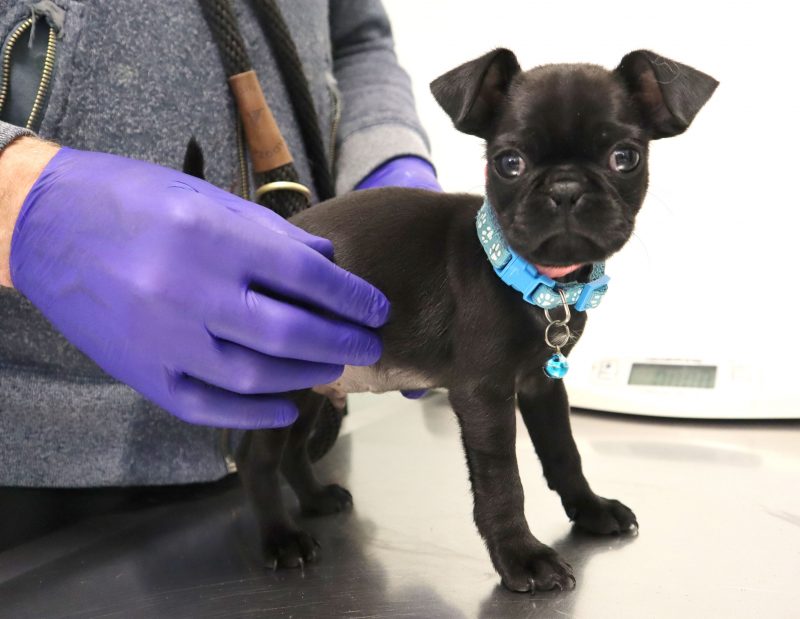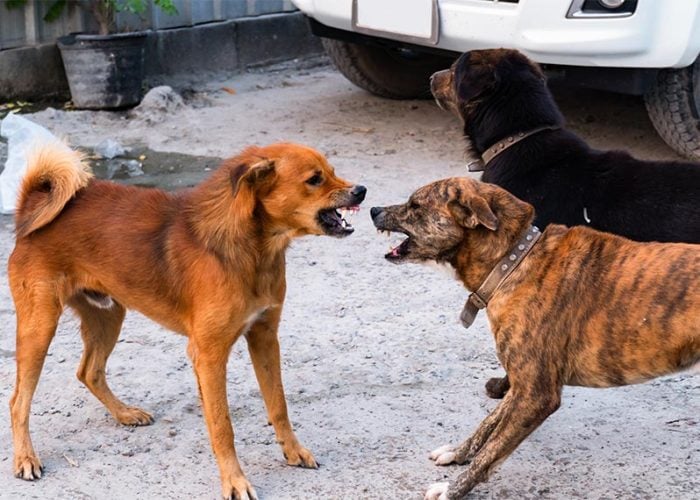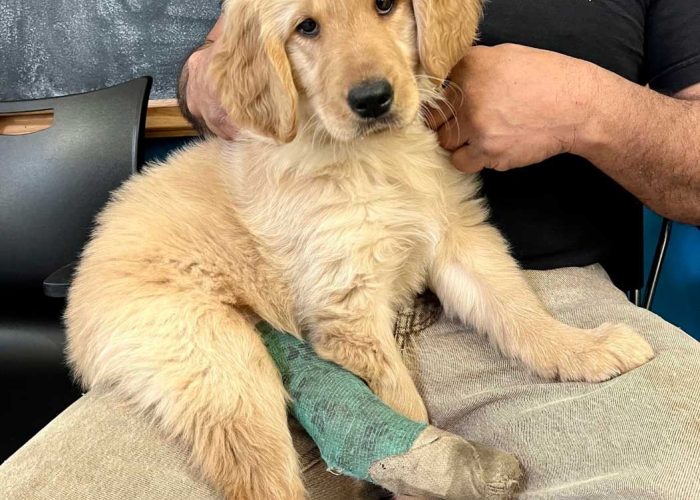Among diseases dogs can contract, parvovirus is one of the most heartbreaking, because it’s very contagious, lives a long time in the environment, and can wreak havoc on an unvaccinated pet, especially puppies, causing death. It’s no joke. We want to make sure you know everything you need to know about what it is, how it’s spread, and how you can protect your dog, so we sat down with our own Dr. Melia Washington to get all the details.
Q: So, what is parvo?
A: Parvovirus has been in existence for decades. An interesting fact about parvo is that multiple species, even humans, can be infected with some type of parvovirus. This virus only likes its specific species host, meaning human parvo only infects humans, pigs only pigs, dogs only dogs, and so on!
Canine parvovirus was first discovered in the 1960’s and about 10 years later in the 1970’s it started to wreak havoc on our canine companions. At that time no vaccine existed and veterinarians’ only option was a closely related feline vaccine. Viral strains mutated and new vaccine options emerged quickly in the veterinary field and thankfully, our current vaccines provide us with almost complete protection against this virus if protocols are followed by pet owners!

Q: How do dogs get it?
A: Parvo is a tough and hardy virus. It is hard to kill and can stay in the environment for weeks to months. Parvo is shed in extremely large numbers by infected dogs. This means that there is virus everywhere: on every carpet, on every floor, in every yard and park that infected pets come in contact with. Virus is shed in the stool for the first two weeks or less after the initial infection but only a tiny portion of infected stool – which could be months old depending on the environmental temperature and humidity – is needed to infect a non-immune dog.
It is hard to kill and can stay in the environment for weeks to months.
Some pets can be “sub-clinically” infected, which means they are shedding the virus all over town but the owner has no idea because the pet isn’t actually sick. It doesn’t matter if the dog does his or her business directly on a certain surface. Fecal material can be transported on the tail, the feet and even the mouths of our pets! Only a small amount of this virus is needed to infect an immunocompromised (aka unvaccinated, unexposed) pet, thus making it extremely important to confine your new puppy for the first few months of life.
The most common route of infection and exposure for your pet is direct contact with the fecal material of another dog shedding the virus, be it sick or subclinical. But, your pet can also become exposed to parvo by coming in contact with any of the previously mentioned areas, and you will never know if another sick or subclinical pet has touched that same surface.

Q: So that folks know what to look for, what are the symptoms of parvo?
A: Parvo symptoms typically happen quickly and are isolated to the gastrointestinal tract (stomach and intestines). This virus attacks the microvilli of the intestines causing the entire digestive system to stop working immediately resulting in extreme discomfort for your pet.
The most common symptoms owners will see is acute lack of appetite, lethargy, vomiting and diarrhea; meaning yesterday the pet was totally normal and today will not eat or drink, and is very tired. Vomiting and diarrhea can happen simultaneously with lack of appetite or over the course of 1-2 days. Imagine the worst case of food poisoning you have ever had; that is parvo! Bloody diarrhea is something most owners contribute to parvo, which is true, but can also mean many other things.
The most common symptoms owners will see is acute lack of appetite, lethargy, vomiting and diarrhea; meaning yesterday the pet was totally normal and today will not eat or drink, and is very tired.
Parvo symptoms and recovery from this virus is best with initiating treatment immediately. So, if you notice a change in your pets behavior and eating habits, especially if this pet is a puppy, please take them to your veterinarian right away for testing and treatment.
Q: So, this disease is associated with puppies a lot. Why is that?
A: Puppies, just like babies are what we call “immunocompromised”. Meaning every germ, every bacteria and every virus is brand new. Each human, child, dog and cat will react to new pathogens (bacteria and viruses) very differently.
A puppy’s immune system strength depends a great deal on the mother’s milk, the environment at birth and during nursing and multiple other factors completely out of your control. Over time the body will naturally form defenses against the world’s pathogens, but any new introduction could be incredibly dangerous and there is no way to know what our pets are exposed to on a daily basis.
So, for the same reasons you don’t allow every new person to touch and kiss your baby, we want to keep our puppies away from multiple other dogs and new environments until completely vaccinated. “Completely” vaccinated typically means at least three series of vaccines given 3-4 weeks apart. The age of your pet does matter when initiating vaccine boosters so it is always best to follow the protocols of your veterinarian closely and ask questions if you have them
…we want to keep our puppies away from multiple other dogs and new environments until completely vaccinated.
Q: But it’s not just puppies that can get it, right?
A: Correct! Adult animals, specifically those that are unvaccinated are also at risk for getting parvo. Remember how this virus can be everywhere? On multiple surfaces and places? Well, unfortunately we cannot SEE exactly where this virus has been, so if your 2 year old pet was not vaccinated and was luckily never exposed to this virus as a puppy then it will be a great risk for developing a parvo infection as an adult. Your pet will be introduced to a whole new destructive pathogen when most have had multiple exposures in the form of a vaccine.
The body needs time to react properly to this virus and a vaccine provides a very safe and very small amount of virus to slowly and repeatedly build internal defenses. Again, much like your vaccines in your children or yourself, we need some of them repeatedly before full immunity occurs. It is so important to start this introduction when our pets are babies so they can be strong adults!

Q: What does treatment for parvo look like?
A: Unfortunately, there is no “treatment” for a virus. A virus is tough and is not killed easily, we have to allow the animal’s immune system to fight and overcome the virus on its own. In many situations parvovirus is deadly even with supportive treatment. The term “supportive” treatment is a collective term we use to describe the medications we give. We are “supporting” the immune system’s fight and the more severe the symptoms, the more aggressive the treatment.
In many situations parvovirus is deadly even with supportive treatment.
Going back to our symptoms of vomiting and diarrhea, it is very common that our pets need fluid therapy, anti-vomiting and anti-diarrheal medications. While the immune system is so busy fighting off this virus a counter-strike from bacterial pathogens is common, and antibiotics are also very commonly given. We allow the pet to respond to these supportive medications and determine the continued need each day.
Some clinics will hospitalize your pet on IV fluid therapy, and sometimes we are able to give medications under the skin and treat your pet daily. Regardless of the route of treatment, it is very expensive, very time consuming, incredibly contagious and an extremely painful illness for your pet. Ultimately, this horrible virus is completely preventable!
Q: But this all very easily preventable, isn’t it?
Yes! That is the best part! Proper vaccines, proper isolation at a young age and listening to the guidance of your veterinarian and technicians can prevent this virus and many others!


